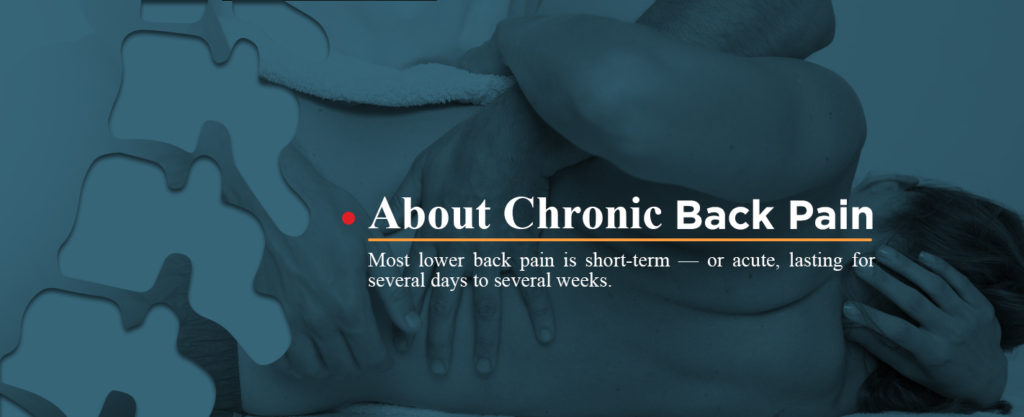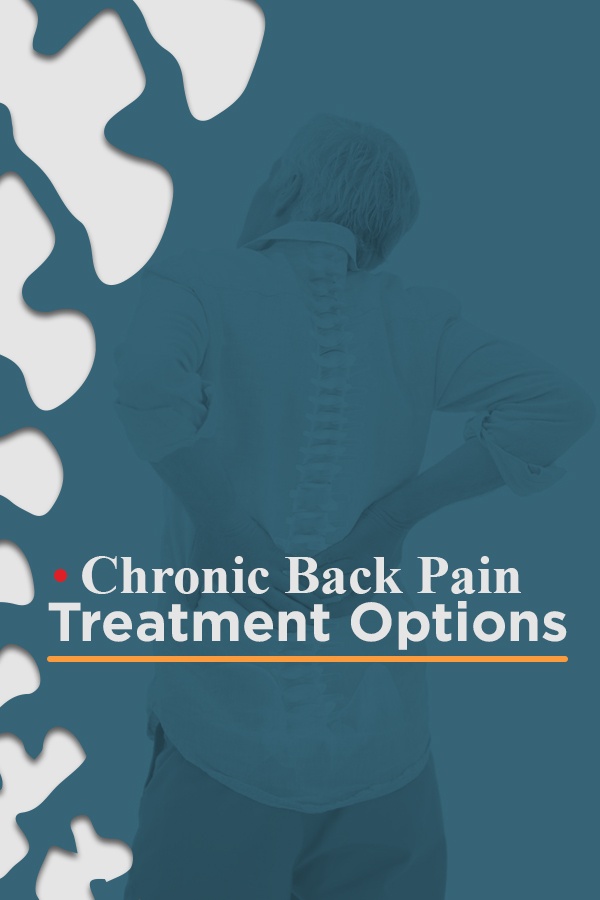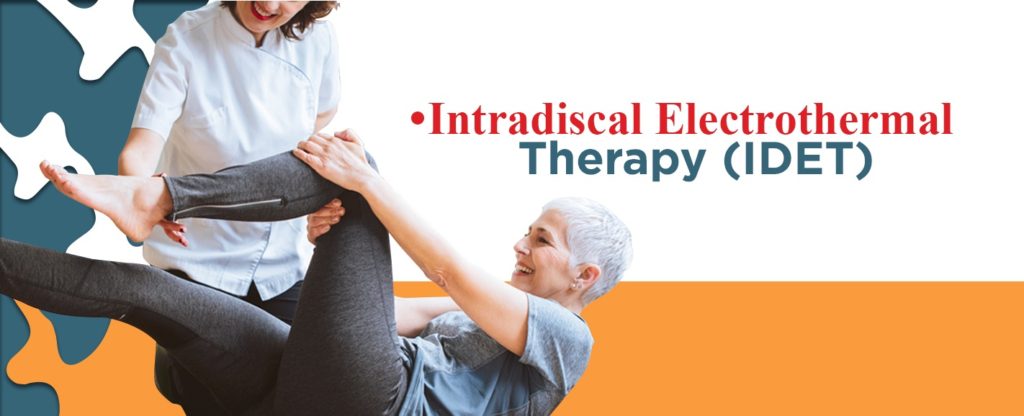If you are struggling with back pain in Central Pennsylvania, you’re part of a vast group. Around 80 percent of adults, at some point in their lives, experience back pain. It’s one of the most common contributors to missed work days and job-related disability, according to the National Institute of Neurological Disorders and Stroke (NINDS). The Orthopedic Institute of Pennsylvania (OIP) provides chronic pain treatment options at our eight locations, including conservative methods and surgical procedures if needed.
About Chronic Back Pain

Most lower back pain is short-term — or acute, lasting for several days to several weeks. But, it often resolves on its own with no residual function loss. Most acute back pain is mechanical, which means there’s a disturbance in how the back’s components — muscle, spine, nerves and intervertebral discs — fit together and move.
Chronic back pain, on the other hand, persists for over 12 weeks even if doctors treat an underlying cause or injury. Around 20 percent of individuals with lower back pain end up developing chronic low back pain with symptoms that persist for at least one year.
If you’ve been suffering from chronic back pain, it’s important you visit us at the OIP to receive a diagnosis for your condition and start treatment to experience pain relief.
Chronic Back Pain Treatment Options

Some treatment options for back pain and lower back pain include:
1. Medications
There are various categories of medicines used for treating chronic pain. Generally, your doctor, pharmacist or pain management specialist can answer your questions regarding the dose and side effects of these medicines. Here are some common medications used for treating chronic pain:
- Nonsteroidal anti-inflammatory drugs (NSAIDs): There are some NSAIDs (like ibuprofen) you can obtain over-the-counter (OTC). NSAIDs could be effective for acute bone and muscle pain along with some forms of chronic pain conditions — like chronic back pain.
- Acetaminophen: You can also easily obtain acetaminophen over-the-counter, but you don’t want to take more than directed because it can have effects on your liver if you take too much. Many opioid medications have acetaminophen in them.
- Antidepressants: Some antidepressants can be helpful in controlling back pain, particularly the tricyclic antidepressants. These medications often relieve pain in lower doses than the standard doses required for treating depression. You don’t take these medications on an “as needed” basis since you have to take them every day regardless of whether or not you’re experiencing pain.
- Muscle relaxants: These drugs are used most often with acute muscle spasms. They are effective at relieving back pain.
- Opioids: Opioids are prescription medications that can effectively control different types of pain when used appropriately. They often require a higher dose with nerve type pain because a normal dose isn’t as effective. Your doctor will prescribe the right amount. For nerve type pain, a doctor might prescribe a long-acting opioid medication. Opioids have an addiction risk, so physicians don’t routinely prescribe them as a first option.
2. Injections
Epidural steroid injections, nerve ablations, nerve blocks and other forms of injection-based procedures can help with chronic back pain relief. Physicians may use them when they don’t know the cause of your pain. They also can sometimes help rule out specific causes if your treatment isn’t working. Injections might lessen or stop the pain for a certain period, but they’re not intended to provide you with a long-term solution, and you shouldn’t use them on their own.
Some common chronic back pain injection procedures are:
Epidural Injections
Epidural steroid injections are one option used for delivering pain medication quickly into your body using a syringe. The doctor injects the medication into the epidural area. This area covers your spinal cord, protecting it and your surrounding nerves from damage.
With an epidural steroid injection, your doctor will use an X-ray machine to guide the needle as they make the injection to ensure the needle is in the right area.
Radiofrequency Ablation (or RFA)
An RFA is a procedure doctors use to reduce pain. RFA is an effective and safe chronic back pain treatment option that’s typically well-tolerated, with barely any associated complications. There’s a very small risk of bleeding and infection at the site of insertion.
The doctor may place an intravenous (IV) line in a vein in your arm before the procedure to deliver a mild sedative and local anesthetic to reduce any discomfort during your RFA procedure. With the local anesthesia, you’ll still be awake, but you won’t feel any pain.
The doctor inserts a small needle into the area you’re experiencing pain. They use an X-ray machine, like with an epidural injection, to guide the needle to the precise area. They then insert a microelectrode through the needle and start the stimulation process. You may feel a tingling sensation.
Before the procedure, you may receive an intravenous (IV) line through vein located in your arm and a mild sedative or local anesthetic to reduce any discomfort during RFA. You may be awake during the process to aid in properly assessing the procedure. Ask your doctor about specifics beforehand.
The doctor places an electrode and needle to send a small radiofrequency current into the surrounding tissue through the electrode, heating the tissue.
Nerve Blocks
Nerve blocks are procedures used for managing or preventing different types of pain. They’re often injections of medications intended for blocking pain from certain nerves. They’re good for pain relief, too.
Nerve blocks use needles, usually combined with ultrasound, fluoroscopy — a tool with a fluorescent screen doctors use to view X-ray images — or CT scan or guide the needle correctly. The doctor might also use low-level electrical stimulation for locating which nerve is causing your pain.
3. Physical Therapy
The best treatment for chronic lower and upper back pain is physical therapy. Doctors tend to prescribe this type of treatment first. You’ll be under the guidance of a spine physical therapist who will guide you through a set of exercises. They’ll tailor the exercises to your condition and specific symptoms. A big part of success is maintaining the exercise routine they provide for you.
Some types of physical therapy used for treating chronic back pain might include:
- Testing your pain tolerance limits: Pain threshold and tolerance will vary from person to person.
- Retraining your posture: The physical therapist will show you the proper form and assist you in achieving the correct posture.
- Strengthening your core: Increasing core strength is important for decreasing back pain and reintegrating patterns of movement with better stability, awareness and bracing of your core.
- Conducting flexibility and stretching exercises: Flexibility and stretching exercises help reduce the tension in the muscles that support your spine, improve overall mobility and range of motion and reduce your risk of disability due to back pain.
- Doing aerobic exercises: Prolonged aerobic exercise can stimulate the nutrients and blood flow to your lower back, decreasing stiffness and encouraging healing.
5. Alternative Treatments
Some chronic back pain patients explore alternative treatments for chronic back pain. These include:
Acupuncture
Acupuncture can help treat chronic back pain. The specialist inserts thin needles into exact points throughout your body. Some specialists believe acupuncture can clear blockages in your body’s life force, which is referred to as Qi — pronounced “chee.”
Chiropractic Care
Different types of chiropractic care treatments many help with managing a chronic back pain like a herniated disc, for example. The treatment might involve manual adjustments where the doctor uses a sudden, controlled force to manipulate your joints to improve the quality and range of motion. Chiropractic care helps restore function and prevent injury as well as provides back pain relief.
Biofeedback
Biofeedback is a body-mind technique involving several types of monitoring devices for creating conscious control over our physical processes our bodies normally automatically control. Some processes biofeedback can affect in this manner could include breath control, heart rate, muscle tension, blood pressure and more.
Today, various types of biofeedback tools and instruments are available that show how effective this therapy can be and help monitor activity progress.
Yoga
Studies involving individuals with mild to moderate chronic back pain show certain yoga postures could decrease pain and improve your ability to move and walk.
Massage Therapy
The medical community is beginning to accept massage therapy as a credible treatment for various forms of back pain and as a supplemental therapy to use with other medical treatments. It offers several potential health benefits for individuals suffering from back pain, including:
- Reduced muscle tension: Massage therapy provides muscle relaxation helping to reduce pain caused by tight muscles, improve flexibility and even improve sleep.
- Improved circulation and blood flow: This brings nutrition to your tissues and muscles, helping in the recovery of muscle soreness from a soft tissue injury (like muscle strain) or physical activity.
- Increased endorphin levels: These are your brain’s “feel good” chemicals. Massage therapy enhances the mood helping to ease the anxiety and depression, often found in people with chronic back pain, which helps decrease pain and speed up recovery.
Behavioral Modification
Behavioral modification methods help optimize patient’s responses to painful stimuli and back pain. Cognitive therapy involves teaching a person to use coping techniques, relaxation techniques and other methods to alleviate back pain.
TENS
Transcutaneous electrical nerve stimulation (TENS) is a type of pain relief where electricity transmits through various parts of your body. Pain relief is a common reason individuals use TENS.
Through this therapy, your body receives mild electrical impulses. The TENS system is made up of a power machine, wires and electrode pads the doctor places on your skin close to the area that hurts. They then turn the unit on and send low-voltage electrical currents through your body.
TENs sessions typically last no more than 15 minutes and depending on the case, are performed as often as needed. Patients often report feeling a warm or mild tingling sensation during the treatments, temporarily preventing the individual from being aware of pain.
6. Surgery
Over 95 percent of our patients’ back problems are treated without surgery at Orthopedic Institute of Pennsylvania. However, when other treatments aren’t effective, doctors might turn to surgery to help relieve pain caused by severe nerve compression or musculoskeletal injuries. Surgery isn’t always successful, and there’s not a lot of evidence showing which surgeries work best for their certain indications. Individuals considering surgery need to know all related risks.
Surgical options may include:
Vertebroplasty and Kyphoplasty
These surgeries are minimally invasive and help repair vertebral compression fractures by osteoporosis. The doctor uses three-dimensional imaging during vertebroplasty to assist them in guiding a fine needle through the patient’s skin into their vertebral body — the biggest part of their vertebrae, the series of small bones that form your backbone.
With these surgeries, the doctor injects glue-like bone cement into your vertebral body space. The cement hardens quickly and helps strengthen and stabilize the bone, providing pain relief. In kyphoplasty, before you receive the bone cement injection, the surgeon inserts a special balloon and inflates it gently to reduce spinal deformity and restore height to your vertebral structure.
Spinal Laminectomy
The doctor performs this treatment when spinal stenosis is causing a spinal canal narrowing that causes numbness, pain or weakness. During the surgery, the surgeon removes the bony walls or lamina of your vertebrae as well as any bone spurs. The goal of this surgery is to open your spinal column up to remove pressure on your nerves.
Discectomy or Microdiscectomy
Your doctor might recommend discectomy to remove a disc, in situations where it has herniated and is pressing on the spinal cord or nerve root and causing enduring and intense pain. Microdiscectomy is a similar procedure, but it involves the surgeon making an extremely small incision in your back to remove the herniated disc, helping with more rapid recovery.
Foraminotomy
Foraminotomy is a surgery that enlarges or “cleans out” the foramen — bony hole — where your nerve root leaves the spinal canal. Joints thickened with age, or bulging discs can lead to narrowing of the space where your spinal nerve exits and may press on your nerve, causing numbness, pain and weakness. The surgeon removes small pieces of bone over your nerve through a small incision, so they can cut the blockage away and relieve the nerve pressure.
Intradiscal Electrothermal Therapy (IDET)

This is surgery for bulging or cracked discs due to degenerative disc disease. During the surgery, the surgeon inserts a catheter at the area of the disc in your back through a small incision. They pass a special wire through the catheter and apply an electrical current to heat the disc, helping to strengthen the disc wall’s collagen fibers, which reduces the bulging or other associated irritation of your spinal nerve.
Other surgical procedures may help with your chronic back pain in the event other treatments fail. You can sit down with an Orthopedic Institute of Pennsylvania provider for a consultation to discuss your treatment options.
Call the Orthopedic Institute of Pennsylvania to Make an Appointment for Your Chronic Back Pain

If you’re experiencing chronic pain or have been injured, it’s important you see a doctor to identify the source of your pain so you can have the best treatment for pain management.
At the Orthopedic Institute of Pennsylvania, providing caring and compassionate service is our priority. We strive to ensure we identify the exact cause of your pain so we can help you treat it properly. Chronic back pain shouldn’t be something you have to deal with every day. It’s our job to help alleviate your pain so that you can get back to living a better quality of life.
Visit here to view our providers in our eight convenient locations throughout Central Pennsylvania, or give us a call at 717-761-5530 to schedule an appointment.


